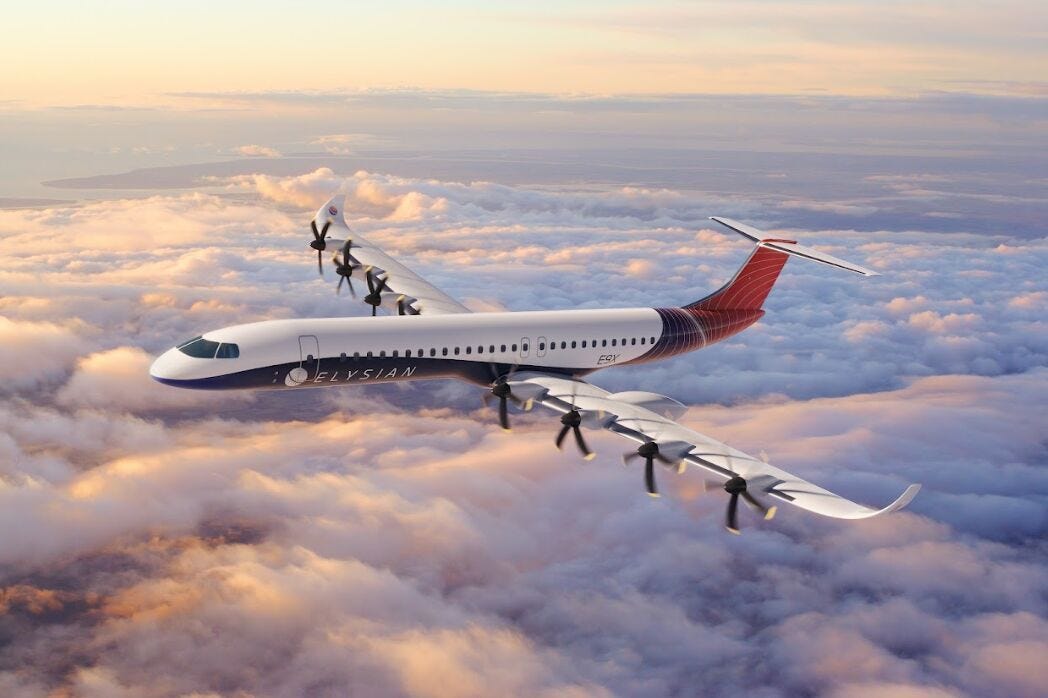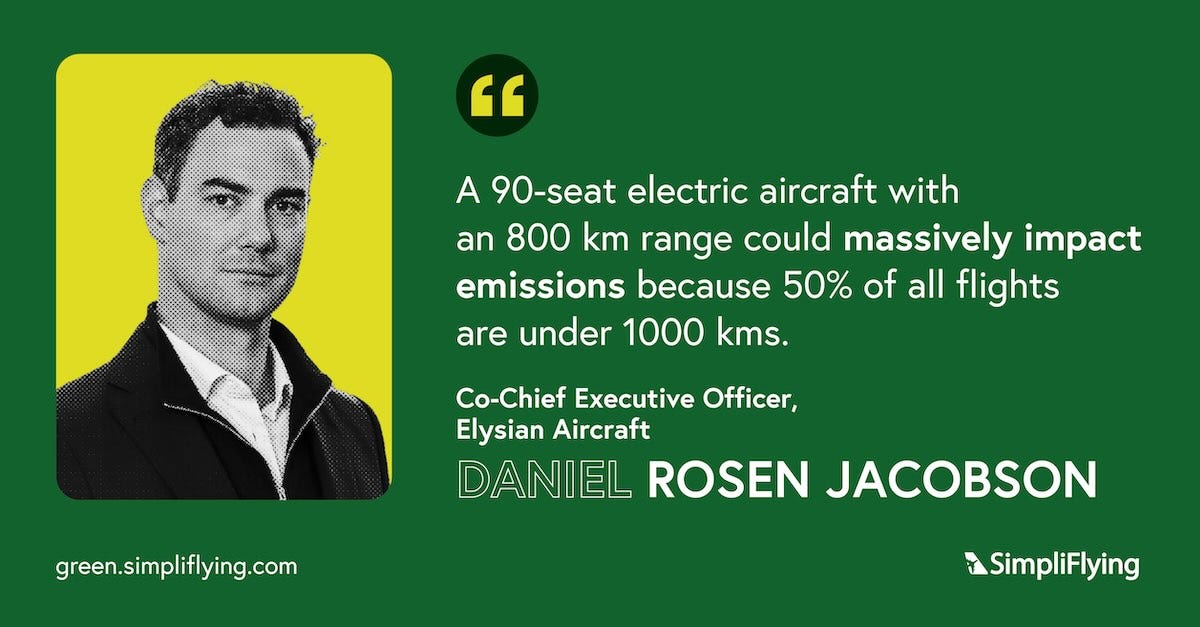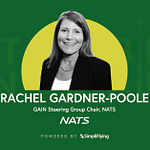In this episode of our ‘Sustainability in the Air’ podcast, Daniel Rosen Jacobson, Co-Founder, Co-CEO and Chief Business Officer of Elysian Aircraft, speaks with SimpliFlying CEO Shashank Nigam about the startup’s unique approach to electric aviation.
Elysian is developing a ground-breaking battery-electric aircraft called E9X from scratch. It can carry 90 passengers to a distance of ~800 km, which is a much greater carrying capacity and range than most current electric aircraft concepts.
Here are the key highlights of the conversation:
Elysian’s 90-seater electric aircraft concept (2:56)
Challenges of battery weight and Elysian’s approach (4:00)
Development timeline and milestones (12:45)
Certification approach and challenges (14:45)
Battery energy density requirements (16:25)
Airport charging infrastructure (19:05)
Funding requirements for Elysian’s E9X (27:20)
Rapid Fire! (36:35)
Keep reading for a quick overview of the episode.
Why Elysian’s 90-seat electric aircraft concept matters
Elysian’s electric aircraft design is quite unique and significantly larger than most electric aircraft concepts. While others in the space have thought smaller planes are the way to go for electric aircraft due to battery limitations, Elysian’s research has shown that there are technical benefits to designing a clean-sheet larger plane.
Jacobson says an electric plane, if designed optimally, can carry more people further. Some of the key design elements of Elysian’s E9x are:
A very large wing with the batteries fully integrated across the entire wingspan. This distributes the weight across the wing, and helps with the aerodynamics.
8 electric motors of 1.4 MW each, distributed across the wing for optimal efficiency.
Low wing configuration with landing gear in dedicated nacelles, rather than being integrated into the fuselage.
A reserve energy system placed in the aircraft for safety.
Low-noise propellers optimised for the electric motors.
Folding wingtips, to allow the plane to have a very long wingspan for aerodynamic efficiency, while still being able to access standard airport gates. To fly 90 passengers over a distance of 800 km with a battery pack of around 360 Wh/kg, the E9X needs a wingspan of 42 metres, says Jacobson. For comparison, this is longer than a Boeing 737’s wingspan.
By targeting short-haul flights with its E9X concept, Elysian believes they can have a real impact on aviation emissions, especially since flights under 1000 km account for 20% of aviation’s CO2 emissions. Moreover, a larger electric plane is likely to achieve similar or lower operating costs compared to current narrow-body jets on high-density short-haul routes. This would allow airlines to offer zero emissions flights while keeping fares accessible for mass market travel, Jacobson adds.
4 takeaways from the conversation
1. Development timeline and certification approach
Elysian is targeting a 2033 entry into service for the E9X.
The company is currently in what Jacobson calls a “risk reduction” phase. In this phase, Elysian is working closely with TU Delft and other research institutes to validate their overarching aircraft concept. They have also identified 10 key challenge areas that are currently being worked on, ranging from battery integration to thermal management to materials.
The next phase would be a “configuration” phase, wherein the overall aircraft configuration will be frozen and a thorough testing of all the major subsystems will begin. 2030 onwards, Elysian expects to build the first full-scale prototype aircraft and begin the formal flight test and certification process.
Certification is one of the biggest challenges for a new electric aircraft design, says Jacobson. There are several novel aspects that will need new certification rules and methods, such as certifying a battery system as an energy storage device, or ensuring safety with a distributed electric propulsion system. Elysian is part of several industry working groups that collaborate with regulators to define these new standards.
2. Airport infrastructure for electric aircraft
For airlines with quick turnarounds between flights, airports will need to have high-power charging infrastructure available at the gates. To work on the issue, Elysian has been working in partnership with airports and ground equipment providers. They are part of several consortiums, such as the Power Up project in the Netherlands, which includes major airports like Amsterdam Schiphol, Rotterdam-The Hague, and Eindhoven, as well as electrical equipment providers. These projects are working to define the standards and infrastructure needed for electric aircraft charging.
Airports will likely also need to install significant battery storage capacity to buffer the electrical grid and provide the high power needed for fast charging. Elysian envisions a future where the batteries from their aircraft, once they reach the end of their useful life onboard, can be repurposed for this energy storage role at airports. This second-life use of batteries will help make the whole system more sustainable.
3. Airline operations with electric aircraft
The success of electric aircraft will depend on how seamlessly they integrate into airline operations and business models. Elysian is designing the E9X with this in mind, and is actively engaging with airlines to understand their requirements.
One of the key operational metrics for short-haul aircraft is turnaround time — the time between when a plane arrives at the gate and when it's ready to depart again. For conventional jets, this can be as short as 20-30 minutes, because “refuelling” is very quick. For the E9X, the turnaround time will depend on the charging time; Jacobson says they are targeting 45 minutes. Since the range of an electric aircraft also depends on the battery charge, airlines will also need to carefully plan their routes and charging stops to ensure the plane always has sufficient energy reserve.
4. Team composition and scale-up plans
Elysian was founded by Jacobson, Rob Wolleswinkel and Reynard De Vries, and is backed by Dutch investment company Panta Holdings that now owns MRO and completions providers Fokker Techniek and Fokker Services. While Fokker itself went bankrupt, much of the expertise and ecosystem that had made it a major global aerospace player still exists. Elysian hopes to tap into that knowledge base through their sister companies under Panta Holdings.
At the moment, Elysian has a small core team of 5 full-time equivalents (FTEs), mostly aerospace engineers. The broader technical team currently consists of about 30 people, a mix of full-time employees and contractors. Elysian also has a close working relationship with the aerospace engineering faculty at TU Delft, which gives them access to some of the best research capabilities. As they move into the next phase of development, Elysian plans to rapidly scale up the team by the end of the year.
‘Sustainability in the Air’ is the world’s leading podcast dedicated to sustainable aviation. Through in-depth conversations with top aviation leaders, we break through the clutter and provide a clear roadmap for a net-zero future.














